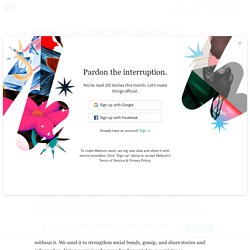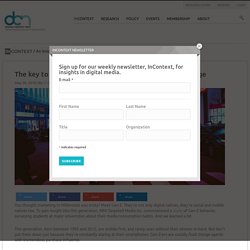

Unlike Millennials: 5 ways Gen Z differs from Gen Y [infographics and slideshares] The Millennials’ time in the limelight is starting to give way to a new cohort. Generation Z—those born between 1996 and 2010—is finally coming of age. Marketers are just starting to understand this generation, but one thing is becoming clear: Gen Zers are decidedly different from the Millennials who preceded them. Jason Dorsey, a researcher and Gen Z expert, went so far as to say that “they don’t want to end up like Millennials.” Gen Z’s purchasing power is now estimated to be $44 billion. The companies that understand these consumers are in the best position to win their affinity…and their business.
So what do we know so far about Gen Z? Shaped by different experiences Gen Z and Millennials differ on what they consider to be epochal events. Different upbringing means different values Gen Z is being raised largely by Gen X parents, while Millennials have Baby Boomer parents. Looking to different influencers As the first true digital natives, Gen Z basically grew up with YouTube. GenZ: The voice-first generation – Liquidlabs. Imagine this: you’re in ancient Greece.

You claim your usual seat in an amphitheatre, where a Greek tragedy is about to commence. The chorus begins to sing and you’re already captivated. Euripides’ Medea is on show and you jeer, weep, laugh and learn. The crowd is riveted as the performers’ voices sail overhead. It’s an unforgettable and moving experience; all of it spoken word. Ever since our ancestors entered the Cognitive Revolution and started developing a complex spoken language some 70 millennia ago, it’s hard to imagine our lives without it. Of course, this is not to dismiss writing. Yet with this dominance of writing in recent history, why suggest Gen Z will become a generation of orators? The answer lies between our love of technology and our love of talking, combined with a culture of “being noticed” and seen.
As we move towards 2020 and beyond, it seems more and more likely that our primary method for communication and information gathering will become voice-first. The User Experience of Libraries: Serving The Common Good User Experience Magazine. Figure 1.

There’s much more to the user experience of a library than navigating the stacks. (Credit: Mauricio Lazo/UH Libraries) Libraries may not be the first thing that comes to mind when thinking about great design. It’s easy to assume the user experience of a library is limited to navigating a maze of bookshelves (see Figure 1). In reality, there has been a recent push among librarians and library professionals to apply user-experience best practices to the design of their services.
Today, UX is a growing specialty in the librarianship profession. UX interest groups within the American Library Association and other library professional groupsDesign-focused library conferences such as Designing for Digital in Austin, TX, and UXLibs in the UKA peer-reviewed journal of library user experience titled “Weave”Hiring of UX-specific roles in libraries, such as UX librarians and UX specialists What a Library UX Professional Does Ongoing Research in a Library Setting The Library Is Your Test Lab.
20 Classroom Management Strategies. Paper airplanes fly across the room. Students race between desks. You can’t get a word in, as they yell over you. It doesn’t have to be this dramatic, like a movie scene you’d watch in a media literacy lesson, but poor classroom management will almost assuredly elevate your stress and burnout rates. Unfortunately, 2006 research indicates that teachers overwhelmingly report lack of professional development support in improving classroom management.
Despite this unideal situation, there are straightforward approaches you can implement by yourself. Available as a downloadable list to keep at your desk, below are 20 research-backed classroom management strategies and techniques. Use the ones that best appeal to your situation and teaching style. Universal classroom management strategies. The key to reaching Gen Z is speaking their digital language. You thought marketing to Millennials was tricky?

Meet Gen Z. They’re not only digital natives, they’re social and mobile natives too. To gain insight into this generation, MNI Targeted Media Inc. commissioned a study of Gen Z behavior, surveying students at major universities about their media consumption habits. And we learned a lot. This generation, born between 1995 and 2012, are mobile-first, and rarely seen without their phones in-hand. They may be young, but they’ll be voting soon – and they’re more fiscally savvy than you think. It’s equally important for marketers to keep messaging relevant and authentic. This generation is smart, and they’ll see right through attempts to “buy” them. The key to making a connection with them is to make sure you know and understand all the channels in which they consume media – that means podcasts, YouTube, Snapchat, Twitter, Instagram, and Facebook, for starters. With this in mind, here are six laws of marketing to Gen Z: 1.
MNI Targeted Media Releases Data to Help Marketers Win Gen Z-ers.